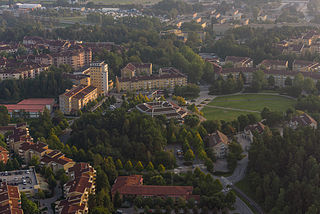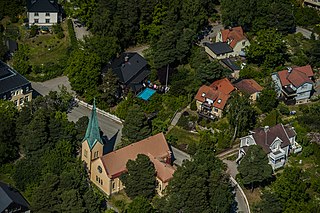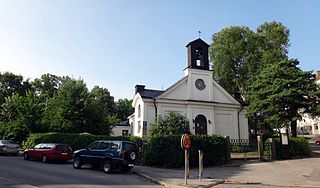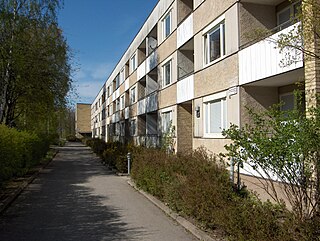
Sundbyberg Municipality is a municipality in Stockholm County in east central Sweden, just north of the capital Stockholm. Sundbyberg is wholly within the Stockholm urban area and has a 100% urban population.

Råsunda is a district in Solna Municipality, and a suburb in the Stockholm metropolitan area with around 17,500 inhabitants. The movie industry set up in the area Filmstaden, formerly an ostrich farm, in 1919–1969 in western Råsunda. A large football stadium stood in central Råsunda 1937–2003, on the grounds of a sports field that existed from 1910. Råsunda can be reached by the Näckrosen metro station, Solna centrum metro and light rail station, the commuter train and light rail Solna station and the major road Frösundaleden. The district neighbours Storskogen and Central Sundbyberg to the west, Skytteholm to the south, Hagalund to the east and Järva the north. The lake Råstasjön is located to the north.

Akalla is a district in Rinkeby-Kista borough, Stockholm, Sweden. Akalla has a population of roughly 9,100 as of 2018, in which immigrants, mostly from Asia and Africa, make up 60.4% of the population.

Kymlinge is an area of Sundbyberg Municipality, Stockholm County, Sweden. It is mostly a recreational park, part of which is a nature reserve (Igelbäcken).

Rissne is a neighborhood in the western part of Sundbyberg Municipality, Stockholm, Sweden. It has about 7500 inhabitants and borders to Stora Ursvik in the north, Duvbo and Hallonbergen in the east, and in the west and south to Bromsten, the latter one within Västerort in Stockholm Municipality. The area belonged to what used to be Spånga municipality until its dissolution in 1949, when it for example together with Duvbo was transferred to Sundbybergs stad. The name comes from Risö, which was the name that the Vikings used. The Svea Artillery Regiment had its camp there until 1960. An apartment block was built 1982 to 1988. The street names in the area hints to the site's military history. and on the many relics contained in Rissne.

Rådhuset metro station is a rapid transit station in Kungsholmen in central Stockholm, part of the Stockholm metro. The station is located on the blue line between T-Centralen and Fridhemsplan and was opened on 31 August 1975 as part the first stretch of the Blue Line between T-Centralen and Hjulsta. The trains were running via Hallonbergen and Rinkeby.

Näckrosen is a station on the Stockholm metro, blue line. The station is located in Solna Municipality, but one of the entrances is in Sundbyberg Municipality. The Näckrosen station was opened on 31 August 1975 as part the first stretch of the Blue Line between T-Centralen and Hjulsta. The trains were running via Hallonbergen and Rinkeby. It is located deep underground under a residential area, close to the Gamla Filmstaden former movie production area.

Duvbo is an upper-middle-class residential area in Sundbyberg in suburban Stockholm, Sweden. In 2019 it had 2217 inhabitants.

Duvbo metro station is a station on the blue line of the Stockholm metro, located in Central Sundbyberg in Sundbyberg Municipality. It is named after the nearby Duvbo area. The station was inaugurated on 18 August 1985 as part of the extension to between Västra skogen and Rinkeby. It became the 98th station of Stockholm metro.

Hallonbergen is a station on the blue line of the Stockholm metro, located in Sundbyberg. The station was opened on 31 August 1975 as part the first stretch of the Blue Line between T-Centralen and Hjulsta. The trains were running to Hallonbergen and then continued to Rinkeby via a track which is currently used for the rail yard access. On 5 June 1977, the extension north to Akalla was opened. The station's interior is covered with art intending to mimic kids' paintings done by Elis Eriksson and Gösta Wallmark. Between 1975 until 1985 Hallonbergen was the branching point for the Akalla and Hjulsta lines, as evident from its three-track layout. On 18 August 1985 the extension from Västra skogen to Rinkeby was opened, and the stretch between Hallonbergen and Rinkeby was closed for passenger traffic.

Husby is a station on the blue line of the Stockholm metro, located in the district of Husby, northern Stockholm. The station was inaugurated on 5 June 1977 as part of the extension from Hallonbergen to Akalla. The distance to Kungsträdgården is 15 km (9.3 mi).

Kista metro station is a station on the blue line of the Stockholm metro, located in the district of Kista, northern Stockholm. The distance to Kungsträdgården is 15.9 km (9.9 mi). It was opened on 5 June 1977 as part of the extension from Hallonbergen to Akalla. The station is the only one on the blue line above ground.

Rinkeby metro station is a station on the blue line of the Stockholm metro, located in the district of Rinkeby. The station was opened on 31 August 1975 as part the first stretch of the Blue Line between T-Centralen and Hjulsta. The trains were running to Hallonbergen and then to Rinkeby via a track which is currently used for the rail yard access. The distance to Kungsträdgården is 12.3 km (7.6 mi).
Central Sundbyberg is the oldest and longest-established part of Sundbyberg Municipality in Sweden. It is a railway town and one of Stockholm's oldest satellite towns, built around Sundbyberg railway station which opened in 1876. Its proximity to Stockholm City Centre, nostalgic environment and well-connected transport networks has made this part of town an attractive housing area.

Lilla Alby is a district in the southern corner of Sundbyberg Municipality, Sweden. It lies southwest of the railway Mälaren Line. It is separated from Bromma by bay Bällstaviken to the southwest, and borders Solna Municipality to the south and east, and Centrala Sundbyberg to the north. Lilla Alby has 4,235 citizens.
Storskogen is a district in Sundbyberg Municipality with 3062 inhabitants, and a suburb in the Stockholm metropolitan area. It is located between Central Sundbyberg and the Solna Municipality district Råsunda. The metro station Näckrosen has an exit here. The area was a mix of forest and meadows until the 1950s, when the current residential area was built there.
Stora Ursvik is a district in Sundbyberg Municipality with 2306 inhabitants, and a suburb in the Stockholm metropolitan area. An unbuilt corner of the district is located in Stockholm Municipality. This residential area is under construction, with an estimated completion in 2026. The first people moved in in 2007. Before that it was farmland owned by the Oxenstierna family, then from the beginning of the 20th century by the Swedish military until 2005. It is connected to Lilla Ursvik to the east and the uninhabited Kymlinge to the north. It is separated by motorways from Rinkeby to the west and Rissne to the south. Two tram stations, on the Tvärbanan Kista line, are planned in the west of the district. The building plan for the district has low buildings in the north and east, and higher buildings in the south and west.
Lilla Ursvik is a district in Sundbyberg Municipality with 1088 inhabitants, and a suburb in the Stockholm metropolitan area. It is located between Stora Ursvik to the west, Kymlinge to the north and Järvastaden to the east, with a motorway separating it from Hallonbergen to the south. Gustaf de Laval had a workshop here 1894-1899. The area was bought in 1906 by the Graham Brothers company, which build a factory here. Freestanding homes for workers were built around the same time.

Ör is a district in Sundbyberg Municipality with 6550 inhabitants, and a suburb in the Stockholm metropolitan area. It is located east of Hallonbergen, and consists of multiresidential buildings from the 1960s. Northern Ör consists of a bus depot, a substation, a school, forest, stables and sports areas.

The Blue line is one of the three Stockholm Metro lines. It is 25.5 kilometres long, and runs from Kungsträdgården via T-Centralen to Västra skogen where it branches in two, and continues to Hjulsta and Akalla as lines 10 and 11 respectively.
















